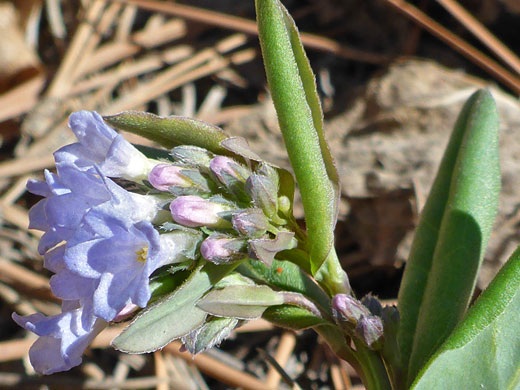Mertensia Oblongifolia, Sagebrush Bluebells
Plants > Wildflowers > Boraginaceae > Mertensia Oblongifolia
Common names:
Sagebrush bluebells, oblongleaf bluebells
Family:
Scientific name:
Mertensia oblongifolia
Main flower color:
Range:
All states west of the Rocky Mountains, though absent from coastal regions, and the far south
Height:
Up to 16 inches
Habitat:
Plains, open slopes, dry meadows, sagebrush; from 5,500 to 8,200 feet
Leaves:
Basal and cauline, oblong, strigose above, hairless below, with a prominent midvein, generally no side veins
Season:
April to June
Mertensia oblongifolia is one of a number of low-growing, medium elevation, early-flowering bluebell species in the West, possibly synonymous with mertensia fusiformis and mertensia brevistyla. One key identifying feature are the leaves; these are oblong in shape, between three and seven times as long as they are wide, with only the midvein prominent (sometimes a pair of faint lateral veins), and they are hairless below, covered by short hairs above, the hairs pressed against the surface, and pointing away from the midvein. Leaves are found at the base and along the stem. Upper leaves are generally sessile, those near the base have short stalks.
Some references, however, class plants with leaves hairy only above as var oblongifolia, while those with both surfaces hairy are var amoena, and those with no leaf hairs are var nevadensis. All varieties are widespread.
Stems are stout, slightly ridged, and clustered. The inflorescence is a dense cluster of pale blue flowers (pink in bud), white towards the base. The corolla tube is much longer than the lobes, and about twice as long as the calyx. Stamens are included; at about the same height as the throat of the corolla. Calyx lobes have ciliate margins.
Some references, however, class plants with leaves hairy only above as var oblongifolia, while those with both surfaces hairy are var amoena, and those with no leaf hairs are var nevadensis. All varieties are widespread.
Stems are stout, slightly ridged, and clustered. The inflorescence is a dense cluster of pale blue flowers (pink in bud), white towards the base. The corolla tube is much longer than the lobes, and about twice as long as the calyx. Stamens are included; at about the same height as the throat of the corolla. Calyx lobes have ciliate margins.
All Contents © Copyright The American Southwest | Comments and Questions | Contribute | Site Map



